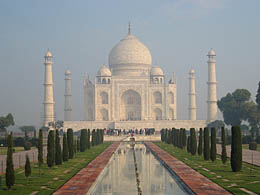
The Indian Taj Mahal is undergoing a complete masonry restoration for the first time
 |
Workers are using a paste made from natural clay to remove the yellowed layer and, with its help, are restoring the marble's original radiant whiteness. This is essentially a clay used for laundry, which some people apply to their skin for cosmetic reasons.
The metal scaffolding that workers have been using for restoration is too heavy and cannot be completely adapted to the mausoleum's structure, said Bhuvan Vikram from the Indian Archaeological Society. According to him, other alternatives are being considered, such as special scaffolding made of bamboo. He added that bamboo scaffolding was already used during intervention by conservationists in the 1940s.
Vikram stated that in the past, the Taj Mahal was cleaned by rain, but air pollution has taken its toll over the last 25 years. "The mausoleum's yellowing can be seen with the naked eye," he said. "In places where rain does not reach, it even turns black," he added. The work is expected to be completed in 2019. The restoration is estimated to cost half a million dollars (just under 11 million Kč).
The tourist guide Fodor's has decided to add the Taj Mahal to the list of places not worth visiting next year due to the restoration work. "If your vision of visiting the Taj Mahal does not include a photograph in front of the mausoleum under a layer of mud and scaffolding, postpone it until at least 2019," the guide recommends.
However, Vikram disagrees—he believes that photographs from the 1940s, when the monument was surrounded by scaffolding, are interesting and historically significant. "Tourists should appreciate that they are witnessing ongoing work, the effort to preserve the monument," he explained.
The Taj Mahal is visited by seven to eight million tourists annually. It was commissioned by the ruler Shah Jahan in memory of his wife Mumtaz Mahal, who died during the birth of their 14th child. The white marble monument was built by an army of stonemasons and workers over 22 years.
The surface of the Taj Mahal, which is an example of Mughal architecture, is adorned with semi-precious and precious stones, and its color changes depending on the light. It has been on the UNESCO list of cultural monuments since 1983.
The English translation is powered by AI tool. Switch to Czech to view the original text source.
0 comments
add comment
Related articles
0
10.06.2014 | Indie will cover the famous Taj Mahal with mud to remove pollution
0
15.02.2008 | Indian specialists are whitening the Taj Mahal, wrapping it in mud
0
08.07.2007 | Business cards of the seven new wonders of the world
0
15.05.2007 | Taj Mahal is turning yellow due to pollution, conservators will cover it with mud










